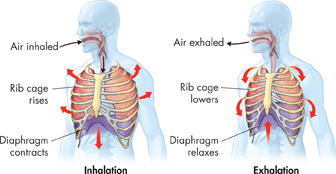
FIGURE 33–17 Breathing During inhalation, the rib cage rises and the diaphragm contracts, increasing the size of the chest cavity. During exhalation, the rib cage lowers and the diaphragm relaxes, decreasing the size of the chest cavity. Humans have some conscious control over breathing—when they swim or play an instrument, for example.
dInhalation The lungs are sealed in two sacs, called pleural membranes, inside the chest cavity. At the bottom of the chest cavity is a large dome-shaped muscle known as the diaphragm.
As Figure 33–17 shows, when you inhale, the diaphragm contracts and flattens. Muscles between the ribs also contract, raising the rib cage. These actions increase the volume of the chest cavity. Because the chest cavity is tightly sealed, this creates a partial vacuum inside the cavity. Atmospheric pressure does the rest, filling the lungs as air rushes into the breathing passages.
Exhalation During ordinary breathing, exhalation is usually passive. Both the rib cage and the diaphragm relax. This relaxation decreases the volume of the chest cavity and makes air pressure in the chest cavity greater than atmospheric pressure. Air rushes back out of the lungs. To blow out a candle, speak, sing, or yell, however, you need more force than passive exhalation provides. The extra force is provided by muscles between the ribs and abdominal muscles, which contract vigorously as the diaphragm relaxes.
The system works only because the chest cavity is sealed. If a wound punctures the chest—even if it does not affect the lungs directly—air may leak into the chest cavity and make breathing impossible. This is one reason chest wounds are always serious.

Breathing and Homeostasis You can control your breathing almost any time you want, to blow up a balloon or to play a trumpet. But this doesn't mean that breathing is purely voluntary. Your nervous system has final control of your breathing muscles whether you are conscious or not. This is why people who drown have water in their lungs. When they lose consciousness, they “breathe” water into their lungs.
Breathing is initiated by the breathing center in the part of the brain stem called the medulla oblongata. Sensory neurons in or near the medulla and in some large blood vessels gather information about carbon dioxide levels in the body and send the information to the breathing center. When stimulated, the breathing center sends nerve impulses that cause the diaphragm and chest muscles to contract, bringing air into the lungs. The higher the blood carbon dioxide level, the stronger the impulses. If the blood carbon dioxide level reaches a critical point, the impulses become so powerful that you cannot keep from breathing.

Table of Contents
- Formulas and Equations
- Applying Formulas and Equations
- Mean, Median, and Mode
- Estimation
- Using Measurements in Calculations
- Effects of Measurement Errors
- Accuracy
- Precision
- Comparing Accuracy and Precision
- Significant Figures
- Calculating With Significant Figures
- Scientific Notation
- Calculating With Scientific Notation
- Dimensional Analysis
- Applying Dimensional Analysis




